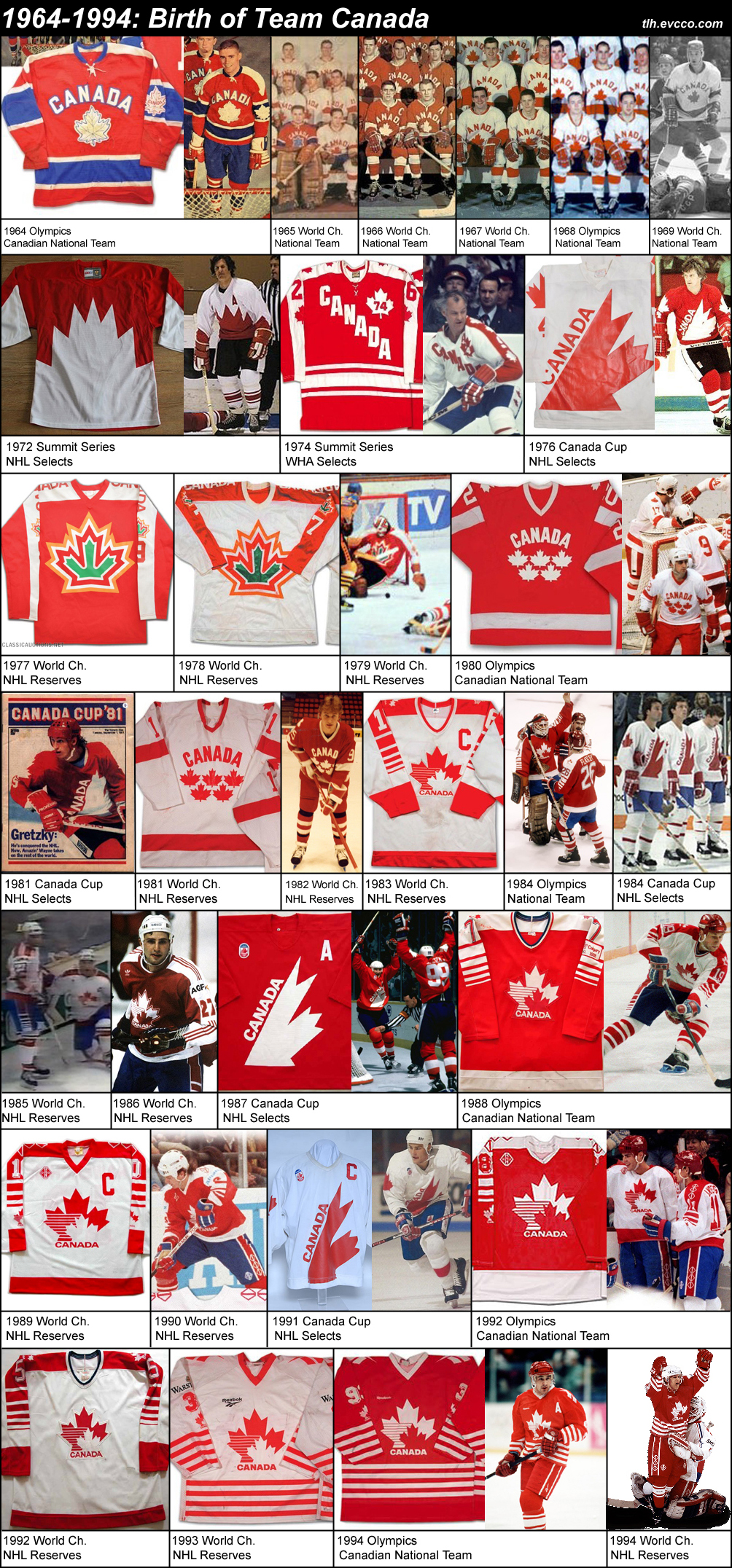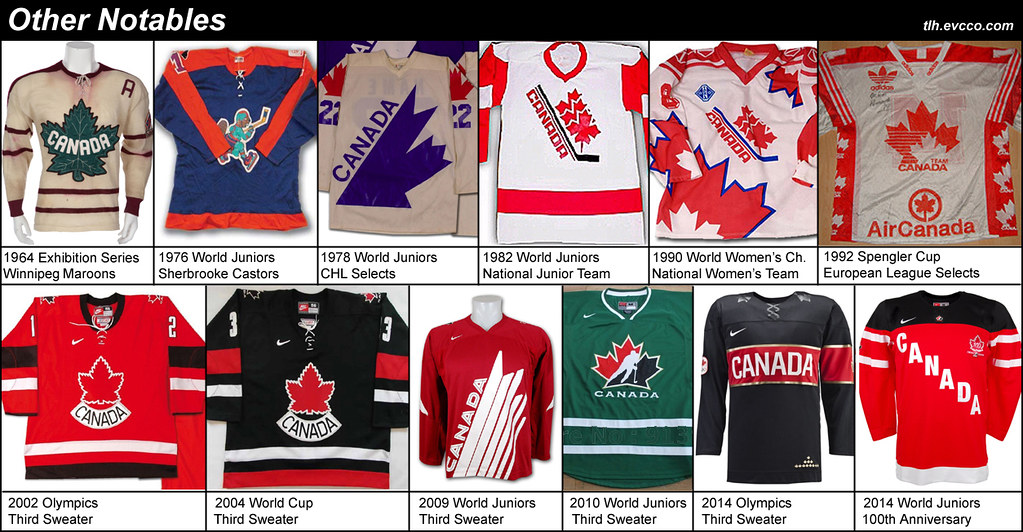EVCco
Registered User
- Dec 16, 2012
- 22
- 9
The recent 100th Anniversary uniforms sported by the Canadian Junior team (and I believe, also the Spengler Cup team) got a lot of people talking, including here - and thinking, including me - about the history of the Canadian uniform. Hockey Canada's website has an interesting page addressing this (http://jerseys.hockeycanada.ca), and there's a few good articles written about the subject elsewhere. But nowhere online could I find a truly comprehensive register of all the uniforms worn by every Canadian team since the beginning, so I'm attempting one here - or, at least, a register of every primary senior men's team uniform.
This first selection is not of official Canadian teams, per se, but of important precursors. While never claiming to represent anyone but their own club, it might be argued that the Montreal AAA team who competed at the 1886 Burlington Carnival of Winter Sports, was the first side to inherit the mantle of "Team Canada" when they played the Van Ness House Club of Vermont in the world's first ever international ice hockey match. No photographic record of that team exists that I know of, but a shot of the squad from a year earlier suggests what they might have looked like. Barely visible on their sweaters is the famed "winged wheel" crest of the Montreal Amateur Athletic Association (later adopted by the Detroit Red Wings), which appears more prominently in a photo from a few years later. By all accounts their colours were Blue and White. The second such "Team Canada" was the Montreal Crystals, who also played Van Ness in the same tournament, although I could find no documentation of their uniforms.
Perhaps the first hockey team to represent Canada in name (albeit, still unofficially) was not actually from Canada at all. The Oxford Canadians were formed in 1905 by Canadian students at Oxford University after being barred from joining the official school hockey club (apparently being Canadian was considered an unfair advantage). Apart from regularly dominating local English sides, the team would also go on to participate in the inaugural European Ice Hockey Championship (forerunner of today's IIHF World Championships) in 1910, being named unofficial champions of the tournament after official winners Great Britain declined to play them. According to Oxford's website (http://oxfordicehockey.com/club-heritage), the Canadians' uniforms at that tournament "consisted of blue ‘shorts’ and a white sweater with a maple leaf on the breast ... the main difficulty was to get a good design of a maple leaf as there was not even a picture of one in the village." Oxford sent another group of Canadians to the first Spengler Cup in 1923, which they also won. While they were now known only as Oxford University, their uniforms were still all-Canadian, featuring a maple leaf emblazoned with a "C". Another unofficial "Team Canada" of the age similarly consisted of ex-pats playing outside the country - the San Francisco Canadian Club team, which competed in the California Amateur Hockey Association...

View full size: https://farm8.staticflickr.com/7513/16067323290_131426b77c_o.jpg
This next batch of sweaters features the first teams to officially represent Canada on the international stage. Starting with the 1920 Olympic Games, the reigning Allan Cup champion played for the country, which led to a rather eclectic assortment of looks. There was an early attempt at bringing some sense of "uniformity" to Canada's uniforms between 1924 and 1936 (with a crest still reflected in the shoulder badge, and certain "third jerseys", of many Canadian uniforms over the past decade). However, most teams opted for some amalgamation of the Maple Leaf and their own club kit (and sometimes just their club kit, period). A uniform (or uniforms) of particular interest in this era is that of the 1959 World Championships. It would seem Canada sported 2 different designs here, one of which was perhaps the first instance of the now standard Red-White-Black colour scheme (likely owing more to the colour scheme of the Belleville McFarlands than anything else). Also of note, the "Canadas" name plate of the 1930 team, and the 1933 Sea Fleas side (thanks to greyraven8)...

View full size: https://farm8.staticflickr.com/7510/16254692565_c79cc56c6e_o.jpg
1964 marked the dawning of a new age with the formation of Father David Bauer's Canadian National Team, and another attempt at uniform standardization. The program's dissolution, and the introduction of professional competition in the 1970s, however, threw all that out the window. The '72 Summit Series uniform is arguably Canada's most iconic (though some would also say most garish), and began in earnest the now familiar Red-White-Black colour scheme, defying those who would think the addition of Black to the modern uniform was merely a nod to 90s fashion (although that probably played some part as well). However, despite a continuation of this palette through the fist couple of Canada Cups (along with the addition of some Green and Gold to the downright zany 77-79 World Championship uniforms), the dominant colour scheme through this era was actually Red-White-Blue. While this scheme still surprises some, it should not surprise anyone familiar with the debates surrounding the design of the modern Canadian flag (currently celebrating its 50th anniversary), nor anyone familiar with the past uniforms pictured above...

View full size: https://farm8.staticflickr.com/7465/16067316890_9cb2ccd807_o.jpg
The merging of the Canadian Amateur Hockey Association with Hockey Canada in 1994 brings us to the modern age of Canadian uniforms. And though Hockey Canada has often been criticized for subsequently branding its jerseys with their "corporate logo" (a logo, itself, often criticized as being an insipid rip-off of numerous other sports logos), they have, at least, brought some much needed consistency to the look of the national team, even while recent Olympic regulations concerning "corporate logos" have injected a modicum of variety...

View full size: https://farm8.staticflickr.com/7526/16067312240_3d2b8973c0_o.jpg
Below are a few other sweaters that will be known to Canadian hockey fans, which don't quite fall under the rubric of "primary senior men's" uniforms, but are notable nonetheless...

View full size: https://farm8.staticflickr.com/7530/16253846112_023da5e903_b.jpg
...any additions/corrections/comments would be most appreciated. Which do you think were the best? Which the worst? Which the mediocre-est? And what, after all, are the true colours of Canadian hockey?
This first selection is not of official Canadian teams, per se, but of important precursors. While never claiming to represent anyone but their own club, it might be argued that the Montreal AAA team who competed at the 1886 Burlington Carnival of Winter Sports, was the first side to inherit the mantle of "Team Canada" when they played the Van Ness House Club of Vermont in the world's first ever international ice hockey match. No photographic record of that team exists that I know of, but a shot of the squad from a year earlier suggests what they might have looked like. Barely visible on their sweaters is the famed "winged wheel" crest of the Montreal Amateur Athletic Association (later adopted by the Detroit Red Wings), which appears more prominently in a photo from a few years later. By all accounts their colours were Blue and White. The second such "Team Canada" was the Montreal Crystals, who also played Van Ness in the same tournament, although I could find no documentation of their uniforms.
Perhaps the first hockey team to represent Canada in name (albeit, still unofficially) was not actually from Canada at all. The Oxford Canadians were formed in 1905 by Canadian students at Oxford University after being barred from joining the official school hockey club (apparently being Canadian was considered an unfair advantage). Apart from regularly dominating local English sides, the team would also go on to participate in the inaugural European Ice Hockey Championship (forerunner of today's IIHF World Championships) in 1910, being named unofficial champions of the tournament after official winners Great Britain declined to play them. According to Oxford's website (http://oxfordicehockey.com/club-heritage), the Canadians' uniforms at that tournament "consisted of blue ‘shorts’ and a white sweater with a maple leaf on the breast ... the main difficulty was to get a good design of a maple leaf as there was not even a picture of one in the village." Oxford sent another group of Canadians to the first Spengler Cup in 1923, which they also won. While they were now known only as Oxford University, their uniforms were still all-Canadian, featuring a maple leaf emblazoned with a "C". Another unofficial "Team Canada" of the age similarly consisted of ex-pats playing outside the country - the San Francisco Canadian Club team, which competed in the California Amateur Hockey Association...

View full size: https://farm8.staticflickr.com/7513/16067323290_131426b77c_o.jpg
This next batch of sweaters features the first teams to officially represent Canada on the international stage. Starting with the 1920 Olympic Games, the reigning Allan Cup champion played for the country, which led to a rather eclectic assortment of looks. There was an early attempt at bringing some sense of "uniformity" to Canada's uniforms between 1924 and 1936 (with a crest still reflected in the shoulder badge, and certain "third jerseys", of many Canadian uniforms over the past decade). However, most teams opted for some amalgamation of the Maple Leaf and their own club kit (and sometimes just their club kit, period). A uniform (or uniforms) of particular interest in this era is that of the 1959 World Championships. It would seem Canada sported 2 different designs here, one of which was perhaps the first instance of the now standard Red-White-Black colour scheme (likely owing more to the colour scheme of the Belleville McFarlands than anything else). Also of note, the "Canadas" name plate of the 1930 team, and the 1933 Sea Fleas side (thanks to greyraven8)...

View full size: https://farm8.staticflickr.com/7510/16254692565_c79cc56c6e_o.jpg
1964 marked the dawning of a new age with the formation of Father David Bauer's Canadian National Team, and another attempt at uniform standardization. The program's dissolution, and the introduction of professional competition in the 1970s, however, threw all that out the window. The '72 Summit Series uniform is arguably Canada's most iconic (though some would also say most garish), and began in earnest the now familiar Red-White-Black colour scheme, defying those who would think the addition of Black to the modern uniform was merely a nod to 90s fashion (although that probably played some part as well). However, despite a continuation of this palette through the fist couple of Canada Cups (along with the addition of some Green and Gold to the downright zany 77-79 World Championship uniforms), the dominant colour scheme through this era was actually Red-White-Blue. While this scheme still surprises some, it should not surprise anyone familiar with the debates surrounding the design of the modern Canadian flag (currently celebrating its 50th anniversary), nor anyone familiar with the past uniforms pictured above...

View full size: https://farm8.staticflickr.com/7465/16067316890_9cb2ccd807_o.jpg
The merging of the Canadian Amateur Hockey Association with Hockey Canada in 1994 brings us to the modern age of Canadian uniforms. And though Hockey Canada has often been criticized for subsequently branding its jerseys with their "corporate logo" (a logo, itself, often criticized as being an insipid rip-off of numerous other sports logos), they have, at least, brought some much needed consistency to the look of the national team, even while recent Olympic regulations concerning "corporate logos" have injected a modicum of variety...

View full size: https://farm8.staticflickr.com/7526/16067312240_3d2b8973c0_o.jpg
Below are a few other sweaters that will be known to Canadian hockey fans, which don't quite fall under the rubric of "primary senior men's" uniforms, but are notable nonetheless...

View full size: https://farm8.staticflickr.com/7530/16253846112_023da5e903_b.jpg
...any additions/corrections/comments would be most appreciated. Which do you think were the best? Which the worst? Which the mediocre-est? And what, after all, are the true colours of Canadian hockey?
Last edited:





